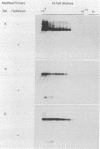Abstract
False-positive results because of carryover contamination by previously amplified nucleic acids are currently the greatest impediment to routine implementation of nucleic acid amplification protocols. We evaluated three methods for inactivation of a 156-bp Borrelia burgdorferi polymerase chain reaction (PCR) product: (i) post-PCR cross-linking with isopsoralen (IP), (ii) pre-PCR treatment of a dU-containing PCR product with uracil N-glycosylase (UNG), and (iii) post-PCR alkaline hydrolysis (primer hydrolysis) of PCR products synthesized by using primers containing 3' ribose residues. The sensitivities of the PCR performed under the conditions of each protocol were comparable. Inactivation of amplified DNA was highly efficient for all three protocols; the IP and UNG protocols eliminated at least to 3 x 10(9) copies of the product. The primer hydrolysis protocol varied in efficiency depending on the number and position of the 3' ribose residues, but inactivation ranged from 10(4) to 10(9) copies. We conclude that with some modifications, all three systems are effective for eliminating amplified DNA products. Routine implementation of at least one method should help to avoid false-positive results because of carryover contamination.
Full text
PDF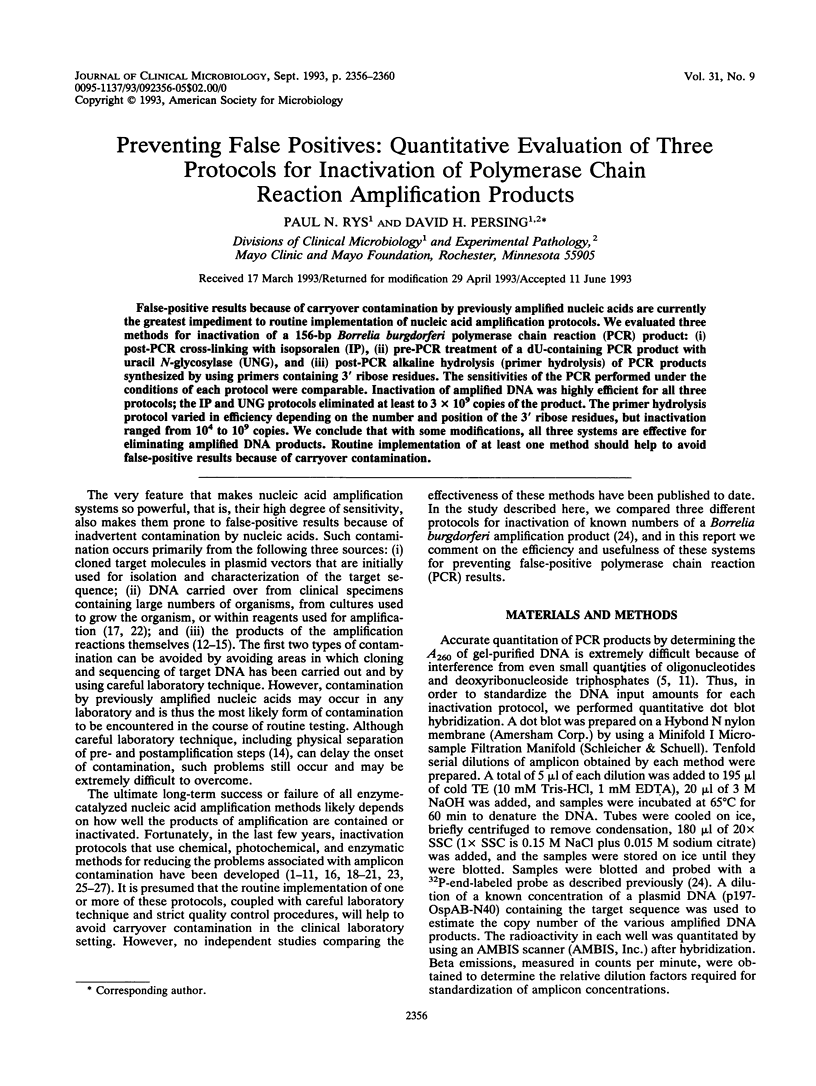
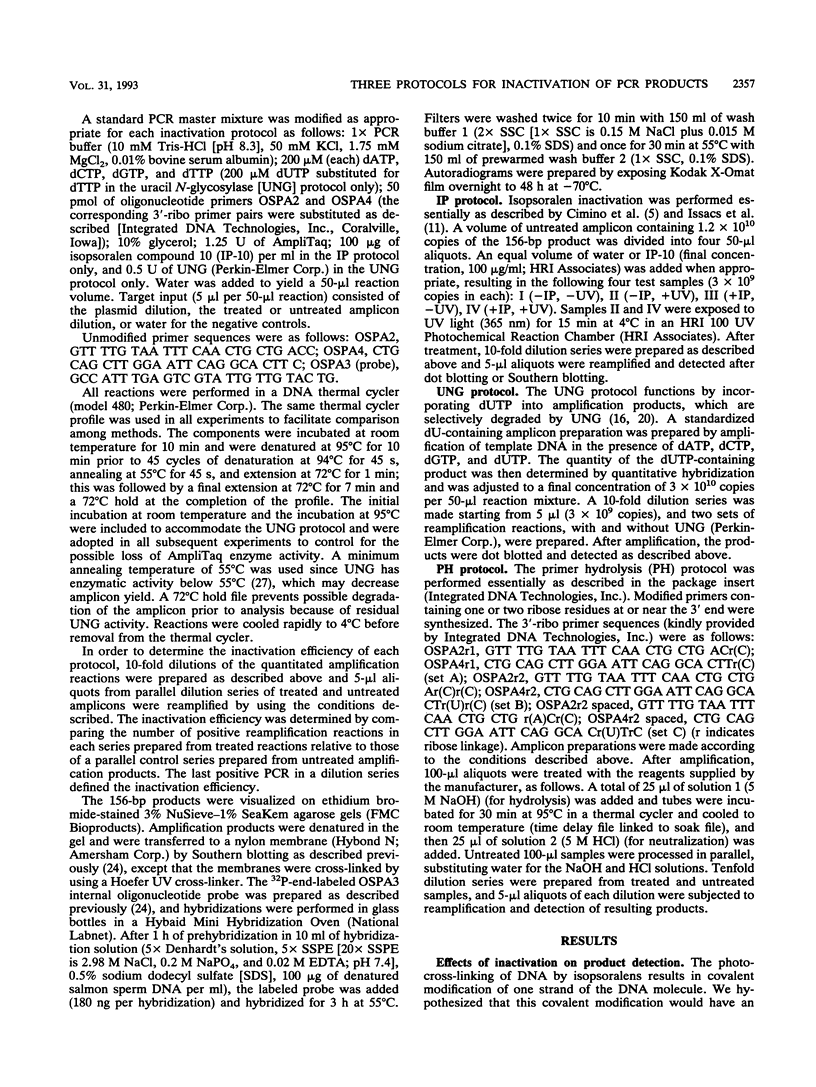
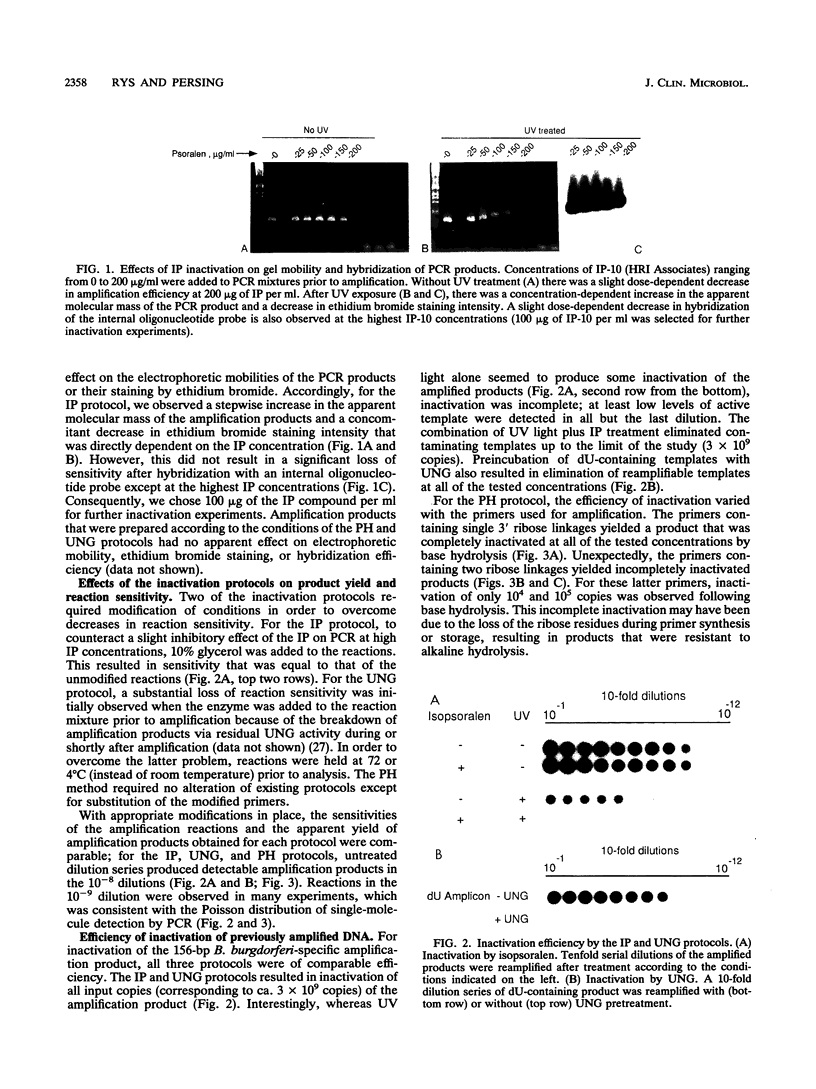
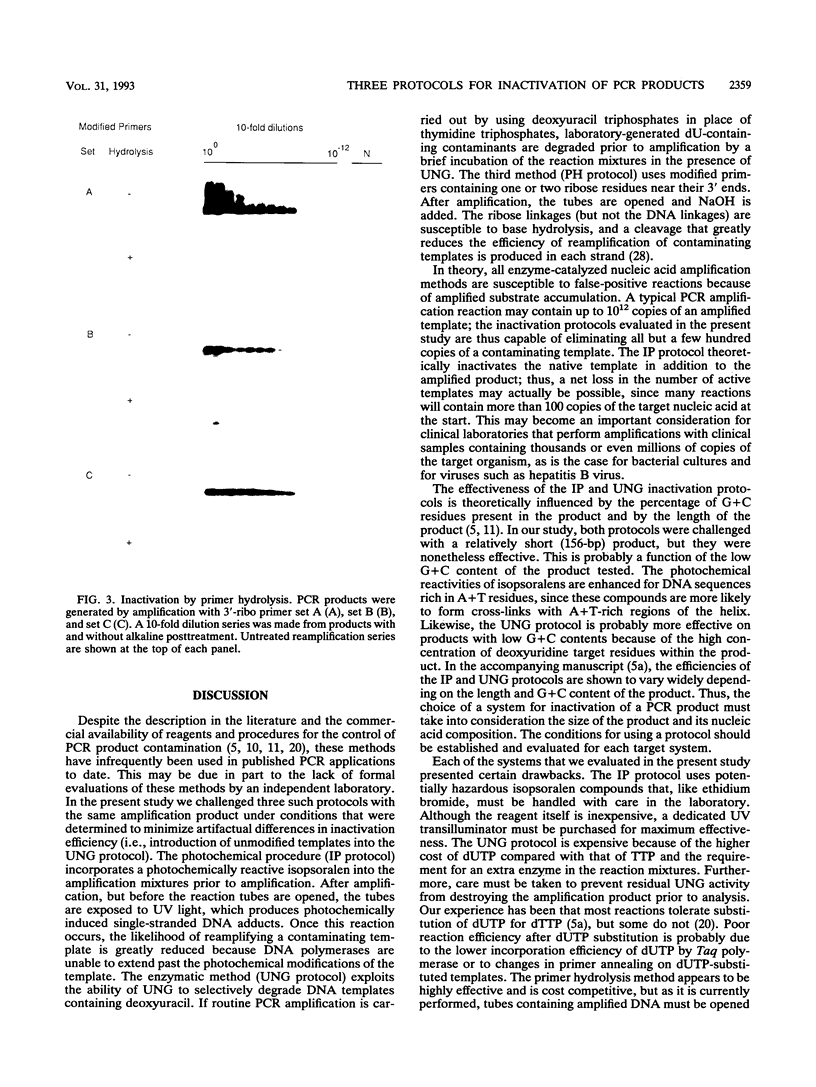
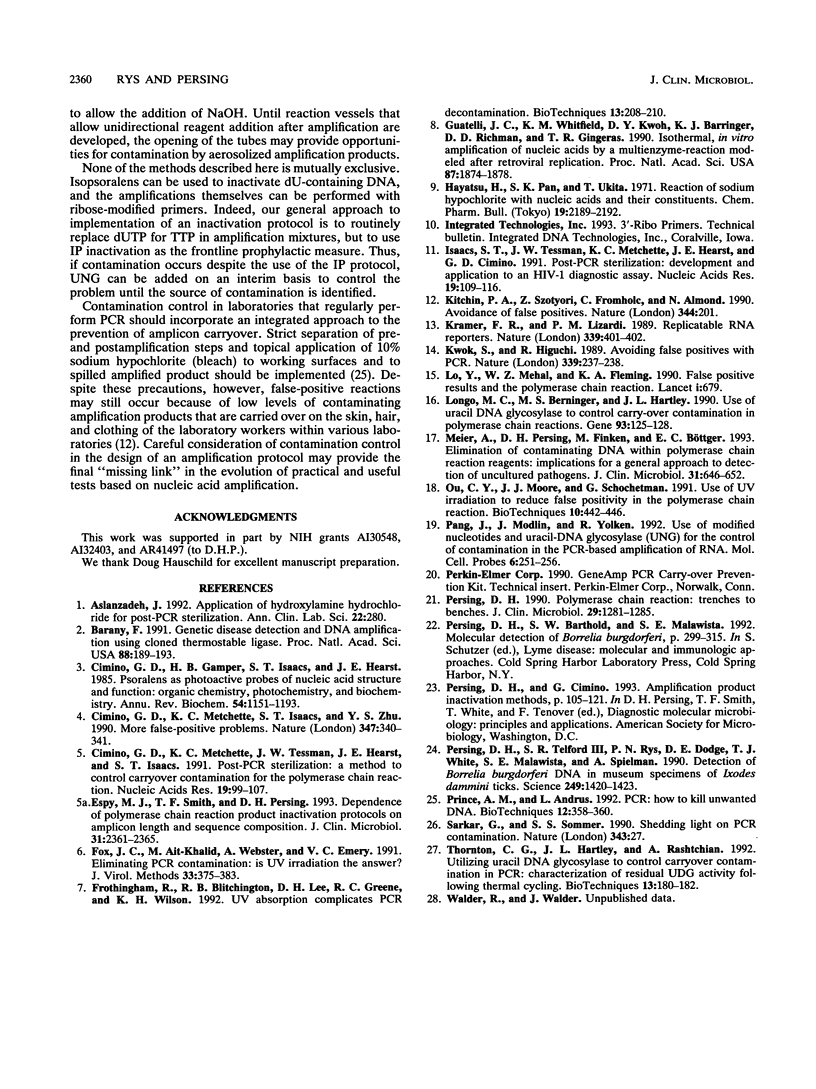
Images in this article
Selected References
These references are in PubMed. This may not be the complete list of references from this article.
- Barany F. Genetic disease detection and DNA amplification using cloned thermostable ligase. Proc Natl Acad Sci U S A. 1991 Jan 1;88(1):189–193. doi: 10.1073/pnas.88.1.189. [DOI] [PMC free article] [PubMed] [Google Scholar]
- Cimino G. D., Gamper H. B., Isaacs S. T., Hearst J. E. Psoralens as photoactive probes of nucleic acid structure and function: organic chemistry, photochemistry, and biochemistry. Annu Rev Biochem. 1985;54:1151–1193. doi: 10.1146/annurev.bi.54.070185.005443. [DOI] [PubMed] [Google Scholar]
- Cimino G. D., Metchette K. C., Tessman J. W., Hearst J. E., Isaacs S. T. Post-PCR sterilization: a method to control carryover contamination for the polymerase chain reaction. Nucleic Acids Res. 1991 Jan 11;19(1):99–107. doi: 10.1093/nar/19.1.99. [DOI] [PMC free article] [PubMed] [Google Scholar]
- Espy M. J., Smith T. F., Persing D. H. Dependence of polymerase chain reaction product inactivation protocols on amplicon length and sequence composition. J Clin Microbiol. 1993 Sep;31(9):2361–2365. doi: 10.1128/jcm.31.9.2361-2365.1993. [DOI] [PMC free article] [PubMed] [Google Scholar]
- Fox J. C., Ait-Khaled M., Webster A., Emery V. C. Eliminating PCR contamination: is UV irradiation the answer? J Virol Methods. 1991 Aug;33(3):375–382. doi: 10.1016/0166-0934(91)90037-z. [DOI] [PubMed] [Google Scholar]
- Frothingham R., Blitchington R. B., Lee D. H., Greene R. C., Wilson K. H. UV absorption complicates PCR decontamination. Biotechniques. 1992 Aug;13(2):208–210. [PubMed] [Google Scholar]
- Guatelli J. C., Whitfield K. M., Kwoh D. Y., Barringer K. J., Richman D. D., Gingeras T. R. Isothermal, in vitro amplification of nucleic acids by a multienzyme reaction modeled after retroviral replication. Proc Natl Acad Sci U S A. 1990 Mar;87(5):1874–1878. doi: 10.1073/pnas.87.5.1874. [DOI] [PMC free article] [PubMed] [Google Scholar]
- Hayatsu H., Pan S., Ukita T. Reaction of sodium hypochlorite with nucleic acids and their constituents. Chem Pharm Bull (Tokyo) 1971 Oct;19(10):2189–2192. doi: 10.1248/cpb.19.2189. [DOI] [PubMed] [Google Scholar]
- Isaacs S. T., Tessman J. W., Metchette K. C., Hearst J. E., Cimino G. D. Post-PCR sterilization: development and application to an HIV-1 diagnostic assay. Nucleic Acids Res. 1991 Jan 11;19(1):109–116. doi: 10.1093/nar/19.1.109. [DOI] [PMC free article] [PubMed] [Google Scholar]
- Kitchin P. A., Szotyori Z., Fromholc C., Almond N. Avoidance of PCR false positives [corrected]. Nature. 1990 Mar 15;344(6263):201–201. doi: 10.1038/344201a0. [DOI] [PubMed] [Google Scholar]
- Kramer F. R., Lizardi P. M. Replicatable RNA reporters. Nature. 1989 Jun 1;339(6223):401–402. doi: 10.1038/339401a0. [DOI] [PubMed] [Google Scholar]
- Kwok S., Higuchi R. Avoiding false positives with PCR. Nature. 1989 May 18;339(6221):237–238. doi: 10.1038/339237a0. [DOI] [PubMed] [Google Scholar]
- Longo M. C., Berninger M. S., Hartley J. L. Use of uracil DNA glycosylase to control carry-over contamination in polymerase chain reactions. Gene. 1990 Sep 1;93(1):125–128. doi: 10.1016/0378-1119(90)90145-h. [DOI] [PubMed] [Google Scholar]
- Meier A., Persing D. H., Finken M., Böttger E. C. Elimination of contaminating DNA within polymerase chain reaction reagents: implications for a general approach to detection of uncultured pathogens. J Clin Microbiol. 1993 Mar;31(3):646–652. doi: 10.1128/jcm.31.3.646-652.1993. [DOI] [PMC free article] [PubMed] [Google Scholar]
- Ou C. Y., Moore J. L., Schochetman G. Use of UV irradiation to reduce false positivity in polymerase chain reaction. Biotechniques. 1991 Apr;10(4):442–446. [PubMed] [Google Scholar]
- Pang J., Modlin J., Yolken R. Use of modified nucleotides and uracil-DNA glycosylase (UNG) for the control of contamination in the PCR-based amplification of RNA. Mol Cell Probes. 1992 Jun;6(3):251–256. doi: 10.1016/0890-8508(92)90024-r. [DOI] [PubMed] [Google Scholar]
- Persing D. H. Polymerase chain reaction: trenches to benches. J Clin Microbiol. 1991 Jul;29(7):1281–1285. doi: 10.1128/jcm.29.7.1281-1285.1991. [DOI] [PMC free article] [PubMed] [Google Scholar]
- Persing D. H., Telford S. R., 3rd, Rys P. N., Dodge D. E., White T. J., Malawista S. E., Spielman A. Detection of Borrelia burgdorferi DNA in museum specimens of Ixodes dammini ticks. Science. 1990 Sep 21;249(4975):1420–1423. doi: 10.1126/science.2402635. [DOI] [PubMed] [Google Scholar]
- Prince A. M., Andrus L. PCR: how to kill unwanted DNA. Biotechniques. 1992 Mar;12(3):358–360. [PubMed] [Google Scholar]
- Sarkar G., Sommer S. S. Shedding light on PCR contamination. Nature. 1990 Jan 4;343(6253):27–27. doi: 10.1038/343027a0. [DOI] [PubMed] [Google Scholar]
- Sarkar G., Sommer S. More light on PCR contamination. Nature. 1990 Sep 27;347(6291):340–341. doi: 10.1038/347340b0. [DOI] [PubMed] [Google Scholar]
- Thornton C. G., Hartley J. L., Rashtchian A. Utilizing uracil DNA glycosylase to control carryover contamination in PCR: characterization of residual UDG activity following thermal cycling. Biotechniques. 1992 Aug;13(2):180–184. [PubMed] [Google Scholar]





